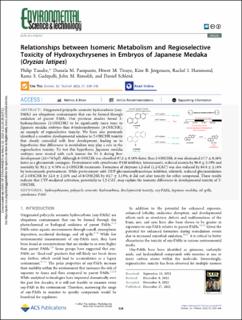| dc.contributor.author | Tanabe, Philip | |
| dc.contributor.author | Pampanin, Daniela Maria | |
| dc.contributor.author | Tiruye, Hiwot Minwuyelet | |
| dc.contributor.author | Jørgensen, Kåre Bredeli | |
| dc.contributor.author | Hammond, Rachel | |
| dc.contributor.author | Gadepalli, Rama S. | |
| dc.contributor.author | Rimoldi, John M. | |
| dc.contributor.author | Schlenk, Daniel | |
| dc.date.accessioned | 2023-03-15T13:28:49Z | |
| dc.date.available | 2023-03-15T13:28:49Z | |
| dc.date.created | 2023-01-26T11:21:53Z | |
| dc.date.issued | 2022 | |
| dc.identifier.citation | Tanabe, P., Pampanin, D. M., Tiruye, H. M., Jørgensen, K. B., Hammond, R. I., Gadepalli, R. S., ... & Schlenk, D. (2022). Relationships between isomeric metabolism and regioselective toxicity of hydroxychrysenes in embryos of Japanese medaka (Oryzias latipes). Environmental Science & Technology, 57(1), 539-548. | en_US |
| dc.identifier.issn | 0013-936X | |
| dc.identifier.uri | https://hdl.handle.net/11250/3058479 | |
| dc.description.abstract | Oxygenated polycyclic aromatic hydrocarbons (oxy-PAHs) are ubiquitous contaminants that can be formed through oxidation of parent PAHs. Our previous studies found 2-hydroxychrysene (2-OHCHR) to be significantly more toxic to Japanese medaka embryos than 6-hydroxychrysene (6-OHCHR), an example of regioselective toxicity. We have also previously identified a sensitive developmental window to 2-OHCHR toxicity that closely coincided with liver development, leading us to hypothesize that differences in metabolism may play a role in the regioselective toxicity. To test this hypothesis, Japanese medaka embryos were treated with each isomer for 24 h during liver development (52–76 hpf). Although 6-OHCHR was absorbed 97.2 ± 0.18% faster than 2-OHCHR, it was eliminated 57.7 ± 0.36% faster as a glucuronide conjugate. Pretreatment with cytochrome P450 inhibitor, ketoconazole, reduced anemia by 96.8 ± 3.19% and mortality by 95.2 ± 4.76% in 2-OHCHR treatments. Formation of chrysene-1,2-diol (1,2-CAT) was also reduced by 64.4 ± 2.14% by ketoconazole pretreatment. While pretreatment with UDP-glucuronosyltransferase inhibitor, nilotinib, reduced glucuronidation of 2-OHCHR by 52.4 ± 2.55% and of 6-OHCHR by 63.7 ± 3.19%, it did not alter toxicity for either compound. These results indicate that CYP-mediated activation, potentially to 1,2-CAT, may explain the isomeric differences in developmental toxicity of 2-OHCHR. | en_US |
| dc.language.iso | eng | en_US |
| dc.publisher | American Chemical Society | en_US |
| dc.rights | Navngivelse 4.0 Internasjonal | * |
| dc.rights.uri | http://creativecommons.org/licenses/by/4.0/deed.no | * |
| dc.title | Relationships between Isomeric Metabolism and Regioselective Toxicity of Hydroxychrysenes in Embryos of Japanese Medaka (Oryzias latipes) | en_US |
| dc.type | Peer reviewed | en_US |
| dc.type | Journal article | en_US |
| dc.description.version | publishedVersion | en_US |
| dc.rights.holder | The authors | en_US |
| dc.subject.nsi | VDP::Matematikk og Naturvitenskap: 400::Kjemi: 440 | en_US |
| dc.source.pagenumber | 539-548 | en_US |
| dc.source.volume | 57 | en_US |
| dc.source.journal | Environmental Science and Technology | en_US |
| dc.source.issue | 1 | en_US |
| dc.identifier.doi | 10.1021/acs.est.2c06774 | |
| dc.identifier.cristin | 2115483 | |
| cristin.ispublished | true | |
| cristin.fulltext | original | |
| cristin.qualitycode | 2 | |

